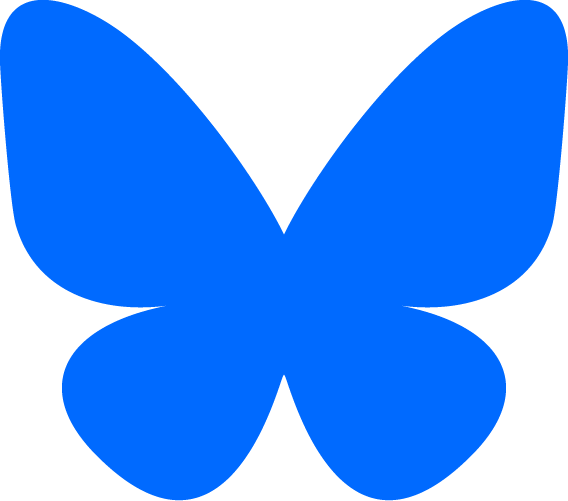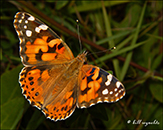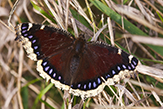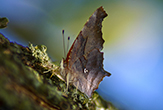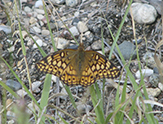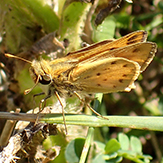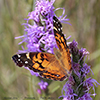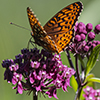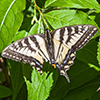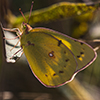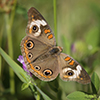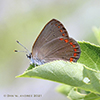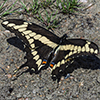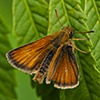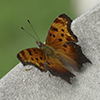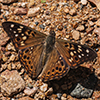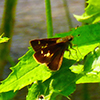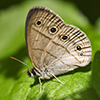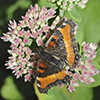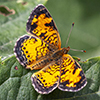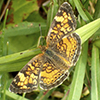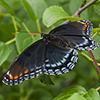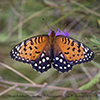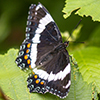Minnesota Butterflies
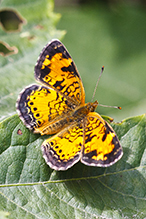
Superfamily Papilionoidea
Lepidoptera is the order of insects that is characterized by having four large wings; mouthparts adapting for sucking, the proboscis in the form of a long coiled tube; and wings and body completely or mostly covered by scales. The order includes butterflies, skippers, and moths.
There are about 174,250 known species in 126 families worldwide, 12,423 species in 82 families in North America north of Mexico. There are at least 1,204 Lepidoptera species found in Minnesota.
Only about 7% of Lepidoptera species are butterflies. According The Lepidopterist’s Society, there are about 18,500 butterfly species worldwide, about 775 species in North America. There are at leat 157 butterfly species in Minnesota, including occasional strays.
Differentiating between butterflies and moths is complicated because on the tree of evolution (phylogenetically) butterflies are moths. The order Lepidoptera was historically divided into four suborders.The suborders Aglossata, Heterobathmiina, and Zeugloptera were all moths. The suborder Glossata contained 44 superfamilies. Two of those superfamilies are butterflies, the remaining superfamilies are moths. Recently, lepidopterists have abandoned suborders and all other taxonomic ranks between orders and superfamilies.
Butterflies have swellings (clubs) at the ends of their antennae. Their wings do not have a frenulum, a specialized structure in most moths that hold the forewings in contact with the hindwings.
Butterflies tend to be larger and have more colorful wings than moths. They fly during the day. When at rest, they hold their wings either spread out to the side horizontally or over their body vertically.
Skippers have traditionally been placed in their own superfamily Hesperioidea because of their morphological similarity. Recent phylogenetic analysis suggests that they share the same common ancestor as other butterfly families, and thus belong in the superfamily, Papilionoidea.
Compared to other butterflies, skippers have relatively large bodies in proportion to their wings. Their wings are small and angular. They hold their hindwings spread out and their forewings either spread out or at a different angle than the hindwings. Most have a thin hooked or pointed extension (apiculus) at the end of each antenna just beyond the club. Skipperlings (subfamily Heteropterinae) do not have an apiculus.
Capitalization of Common Names: Butterflies
Common names of butterflies on this site follow the conventions established in A Catalogue of the Butterflies of the United States and Canada (Pelham) and those used by the North American Butterfly Association (NABA).
These organizations treat the official common names of species as proper nouns to ensure clarity and taxonomic consistency. Capitalizing names like Eastern Tiger Swallowtail distinguishes the specific species from a general description; for example, “the swallowtail” refers to a group, while “the Swallowtail” (when used in a specific name) identifies a unique biological entity. This convention aligns butterfly nomenclature with the standards used for birds, mammals, and reptiles, facilitating precise communication by treating the standard name as a distinct identifier.
Life Cycle
Most adult butterflies live only two to four weeks. In that short period they emerge from their cyrsalis, immediately begin courting, mate, and die. The eggs hatch in 5 to 10 days, and tiny caterpillars emerge and begin feeding. In the next 10 to 14 days the caterpillars eat constantly, grow rapidly, and shed their skin four times. Most caterpillars do not survive this stage. They may be eaten by birds, small animals, or wasps; be parasitized by parasitic wasps or flies; or succumb to a fungal or viral infection. The surviving, fully grown caterpillar attaches itself to a support, usually vegetation, and produces a hard outer shell (crysalis).
|
Monarch (Danaus plexippus) migration is well documented and much studied. In September, adults of the third or fourth generation of the eastern population of monarchs begin congregating in large numbers on the foliage of trees and shrubs near water. By the end of October they have left the state in a mass migration to their winter grounds. They arrive at one of thirteen small overwintering sites in the Sierra Madre mountains between 43 and 105 miles west of Mexico City, Mexico. The following spring the same butterflies begin a northward migration. They lay eggs that will become the first generation in northern Mexico and southern United States between late March and late April. First generation monarchs begin to arrive in Minnesota around mid-May. Northward migrating butterflies arrive in Minnesota around mid-May. They are of a more recent (first) generation, rarely if ever the same individuals (third or fourth generation) that migrated south. Less is known about migration of other butterfly species in North America. There is some disagreement about whether any of them, other than the monarch, migrate south in the fall. There are numerous reports of southward movement or “migration” of butterflies in the literature. However, the reports that I have seen in researching this article, both in print and online, are observational in nature. They do not involve a scientific study of any kind, and may be explained in terms that do not involve migration in its strict sense. Many species cannot survive our harsh winters and die with the arrival of cold temperatures. Their populations are restored the following spring and summer as the seasonal range once again expands into Minnesota. Sometimes an outbreak in the south is followed by large numbers of butterflies being swept north on weather fronts. Both of these northward seasonal movements, while occurring in large numbers, lack intentionality. They could be called “seasonal immigration” to distinguish them from the true migration of the monarch. Red admiral (Vanessa atalanta) migration is well documented in Europe but less not on this side of the Atlantic. The Red Admiral and Painted Lady Research Site states that some red admirals in parts of their North American range move south in the fall and some stay behind. It is not known how many non-migratory individuals in the northern parts of their range successfully overwinter. The “migration” is thought to be one way, meaning that the individuals that move south in the fall are not the same individuals that move north in the spring. The distance of the southward movement is not known, whether it is all of the way or only part of the way to the southern limits of their range. Numerous sources report that painted lady (Vanessa cardui) butterflies migrate south, and that the migration begins in August and continues through November. Painted lady butterflies overwinter in the southwestern United States and in northern Mexico. They immigrate north in the spring in most years, temporarily repopulating the United States and Canada. Some years they do not immigrate at all. In years of much rain on the wintering grounds the northward immigrations are enormous. The El Niño of 2015 is expected to last into the spring of 2016 and should bring much rain to the wintering grounds of the painted lady. American lady (Vanessa virginiensis) butterflies are the hardiest species of Vanessa butterflies. The field guide Butterflies through Binoculars: The East (1999) states that the American lady “Migrates south in the fall...”. In the northern part of its range some may overwinter as adults, hidden in a crevice of tree bark or a human dwelling. In the spring American lady butterflies immigrate north, repopulating northern United States and Canada. Some anglewing species are reported to have both migrating and non-migrating individuals, and that migrating adults move south in the fall. Overwintering adults wedge themselves into small crevices in trees or human buildings. They sometimes fly about on warm sunny days in the dead of winter. Question marks (Polygonia interrogationis) are said to have both migrating and non-migrating individuals. Mourning cloaks (Nymphalis antiopa) are reported to have some migrating individuals by, among other sources, the popular Website Butterflies and Moths of North America, and the field guide Butterflies through Binoculars: The East (1999). According to an entomologist with the Minnesota DNR, “these are movements in response to crowding resulting from a local outbreak.” Compton tortoiseshell (Nymphalis vaualbum) and Milbert’s tortoiseshell (Aglais milberti) butterflies hibernate, sometimes in groups. Variegated fritillary (Euptoieta claudia) does not survive Minnesota winters. It immigrates into Minnesota each year. |
Monarch
Red admiral
Painted lady
American lady
Mourning cloak
Question mark
Variegated fritillary |
Recent Additions
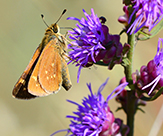
Leonard’s skipper (Hesperia leonardus) is a large, late season, branded skipper. It occurs in North America east of the Rocky Mountains. It is listed as a Special Concern species in Minnesota, where it is declining due to habitat loss, insecticide drift from nearby croplands, and prescribed burning of managed prairies and savannas.
Adults fly from early August to mid-September. They feed on nectar from many flowers, including wild bergamot, common self-heal, round-headed bush clover, asters, goldenrods, spotted knapweed, prairie ironweed, blazing stars, thistles, Joe-pye weed, and sunflowers. Larva feed on grasses.
There are three subspecies of Leonard’s skipper, two of which occur in Minnesota. The western subspecies, Pawnee skipper (Hesperia leonardus pawnee), is found in prairies in the west. The eastern subspecies, Leonard’s skipper (Hesperia leonardus leonardus), is found in dry prairies, savannas, open woodlands, and woodland openings in the east. The ranges of the subspecies overlap in eastern Minnesota, western Iowa, and western Wisconsin. In these areas the subspecies interbreed, producing “blended” offspring that are closer in appearance to Leonard’s skipper. The Leonard’s skippers in eastern Minnesota are all or mostly “blended”.

Northern broken-dash, Dun skipper, and little glassywing are called “the three witches” because their dark wings make it difficult to tell “which one is which.”
Northern broken-dash (Wallengrenia egeremet) is a small, dark, nondescript, grass skipper. It occurs in the United States and southern Canada east of the Rocky Mountains. It is most common in the northeast from Maine to Michigan south to Massachusetts and Ohio. It is uncommon but sometimes locally abundant throughout its range, including in Minnesota. Adults are found from late June to mid-August in open places near wooded or shrubby areas, including fields, pastures, meadows, woodland edges, gardens, and roadsides. They drink nectar from white, pink, and purple flowers, including alfalfa, red clover, dogbane, New Jersey tea, milkweed, and blazing star. Larva feed on the leaves of panic grasses.
The upper side of both wings is dark brown with pale markings and a brownish fringe. On the male the leading edge of the forewing is pale. The group of specialized scent scales (stigma) on the male forewing is black and is interrupted in the middle, like a “broken dash”. This is the feature that gives the species its common name.

Iowa skipper (Atrytone arogos iowa) is a species of special concern in Minnesota. Its populations are restricted to undisturbed tallgrass and shortgrass prairies in the Great Plains. Massive habitat destruction and excessively frequent prescribed burning on managed prairies are major threats to the subspecies survival. It is declining in the northern parts of its range. It is no longer found in 200 western counties it was once known from. It is estimated that there are over 100 remaining populations, but those are small and scattered. It is considered uncommon to rare wherever it occurs. In Minnesota, it is found mostly in the southwest quarter of the state.
Iowa skipper is a small to medium-sized grass skipper. The wings are yellowish-orange with a broad, dark border. The female has a thin black streak in the center of the forewing, but otherwise the wings are unmarked. When at rest, the forewings are held at a 45° angle and the hindwiings are held horizontal, a configuration that resembles an F-15 Eagle fighter jet.
Iowa skipper is similar in appearance to the Delaware skipper (Anatrytone logan), which is much more common. Iowa skipper is distinguished by the lack of any black veining on the upperside of the wings; lack of a black cell end bar on the forewing; wing undersides not as bright; and the hindwing fringe that is usually white, not tan or orange.
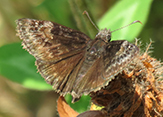
Wild indigo duskywing (Erynnis baptisiae) is a medium-sized spread-wing skipper. It is widespread, abundant, and increasing in the east and the Midwest, but rare in Minnesota.
Wild indigo duskywing was originally a species of open woodlands and shrubby prairies. The larvae fed on mostly on horseflyweed but also blue wild indigo and sundial lupine. With the decline of those species due to habitat loss, the skipper adapted to the introduced, locally abundant species crown vetch. Today, its range is rapidly expanding and its numbers are increasing wherever crown vetch has been widely planted.
Wild indigo duskywing has dark brown wings; a pale spot at the end of the forewing cell; and four translucent white spots at the leading edge near the tip of the forewing. Along with columbine duskywing and Perseus duskywing, it is part of the “Persius species complex”. They are very similar in appearance and difficult or impossible to distinguish in the field. Columbine duskywing is smaller, lighter, and has shorter wings. Perseus duskywing has not been recorded in Minnesota.

Checkered white (Pontia protodice) is a medium-sized butterfly with a wingspan of 1½″ to 2½″. It is a southerly species and is uncommon in Minnesota. There are two overlapping broods here, early June to August (spring form) and July to mid-October (summer form). The wings are white with dark markings, including a checkered pattern on the outer margin. The female has more extensive markings than the male, and the spring form has darker markings than the summer form. The larva (caterpillar), known as the southern cabbageworm.
Checkered white populations have drastically decreased in eastern Unites States, and the butterfly is now scarce or extirpated in some areas where it was once common. It appears stable in the west.
The cause of the decline is unknown, though habitat loss is certainly a contributor. It is possible that the extremely abundant introduced species cabbage white is displacing native whites, including checkered white. It is also possible that checkered white is a western and midwestern species that only sporadically became abundant in eastern agricultural fields. It remains to be seen whether the decline will continue to spread westward.
Other Recent Additions
This list includes only butterflies that have been recorded in Minnesota, but not all of the butterflies found in Minnesota.
| A | |||||
|---|---|---|---|---|---|
| Profile | Photo | Video | |||
Arctic fritillary (Boloria chariclea) |
|||||
|
|||||
|
|||||
|
|||||
|
|||||
|
|||||
|
|||||
|
|||||
|
|||||
|
|||||
|
|||||
|
|||||
|
|||||
|
|||||
|
|||||
|
| B | |||||
|---|---|---|---|---|---|
| Profile | Photo | Video | |||
black dash (Euphyes conspicua) |
|||||
bog copper (Lycaena epixanthe) |
|||||
bog fritillary (Boloria eunomia) |
|||||
bordered patch (Chlosyne lacinia) |
|||||
brown elfin (Callophrys augustinus) |
|||||
|
|||||
|
|||||
|
|||||
|
|||||
|
|||||
|
|||||
|
| C | |||||
|---|---|---|---|---|---|
| Profile | Photo | Video | |||
Chalcedon checkerspot (Euphydryas chalcedona) |
|||||
cloudless sulphur (Phoebis sennae) |
|||||
columbine duskywing (Erynnis lucilius) |
|||||
common branded skipper (Hesperia comma) |
|||||
common sootywing (Pholisora catullus) |
|||||
crossline skipper (Polites origenes) |
|||||
|
|||||
|
|||||
|
|||||
|
|||||
|
|||||
|
|||||
|
|||||
|
|||||
|
|||||
|
|||||
|
|||||
|
|||||
|
|||||
|
|||||
|
|||||
|
|||||
|
|||||
|
|||||
|
|||||
|
|||||
|
|||||
|
|||||
|
| D | |||||
|---|---|---|---|---|---|
| Profile | Photo | Video | |||
dainty sulphur (Nathalis iole) |
|||||
Dakota skipper (Hesperia dacotae) |
|||||
Dion skipper (Euphyes dion) |
|||||
Dorcas copper (Lycaena dorcas) |
|||||
dreamy duskywing (Erynnis icelus) |
|||||
dusted skipper (Atrytonopsis hianna) |
| E | |||||
|---|---|---|---|---|---|
| Profile | Photo | Video | |||
eastern pine elfin (Callophrys niphon) |
|||||
|
|||||
|
|||||
|
|||||
|
|||||
|
|||||
|
|||||
|
|||||
|
|||||
|
|||||
|
|||||
|
|||||
|
|||||
|
|||||
|
|||||
|
| F | |||||
|---|---|---|---|---|---|
| Profile | Photo | Video | |||
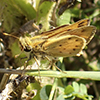 |
|||||
freija fritillary (Boloria freija) |
|||||
frigga fritillary (Boloria frigga) |
|||||
|
| G | |||||
|---|---|---|---|---|---|
| Profile | Photo | Video | |||
Garita skipper (Oarisma garita) |
|||||
gray copper (Lycaena dione) |
|||||
green comma (Polygonia faunus) |
|||||
greenish blue (Plebejus saepiolus) |
|||||
green-veined white (Pieris napi) |
|||||
grizzled skipper (Pyrgus centaureae freija) |
|||||
|
|||||
|
|||||
|
|||||
|
| H | |||||
|---|---|---|---|---|---|
| Profile | Photo | Video | |||
harvester (Feniseca tarquinius) |
|||||
Henry’s elfin (Callophrys henrici) |
|||||
hoary comma (Polygonia gracilis) |
|||||
hoary elfin (Callophrys polios) |
|||||
|
|||||
|
|||||
|
|||||
|
|||||
|
|||||
|
|||||
|
| I | |||||
|---|---|---|---|---|---|
| Profile | Photo | Video | |||
Indian skipper (Hesperia sassacus) |
 |
||||
|
| J | |||||
|---|---|---|---|---|---|
| Profile | Photo | Video | |||
|
|||||
|
| K | |||||
|---|---|---|---|---|---|
| Profile | Photo | Video | |||
Jutta arctic (Oeneis jutta) |
|||||
Juvenal’s duskywing (Erynnis juvenalis) |
| L | |||||
|---|---|---|---|---|---|
| Profile | Photo | Video | |||
large marble (Euchloe ausonides) |
|||||
Laurentian skipper (Hesperia comma laurentina) |
|||||
little yellow (Pyrisitia lisa lisa) |
|||||
long dash (Polites mystic) |
|||||
|
|||||
|
|||||
|
|||||
|
|||||
|
|||||
|
|||||
|
| M | |||||
|---|---|---|---|---|---|
| Profile | Photo | Video | |||
Macoun’s arctic (Oeneis macounii) |
|||||
Mexican yellow (Eurema mexicana) |
|||||
Mormon fritillary (Speyeria mormonia) |
|||||
mottled duskywing (Erynnis martialis) |
|||||
mulberry wing (Poanes massasoit) |
|||||
|
|||||
|
|||||
|
|||||
|
|||||
|
|||||
|
|||||
|
|||||
|
|||||
|
| N | |||||
|---|---|---|---|---|---|
| Profile | Photo | Video | |||
northern blue (Plebejus idas nabokovi) |
|||||
northern grizzled skipper (Pyrgus centaureae freija) |
|||||
northern spring azure (Celastrina lucia) |
|||||
|
|||||
|
|||||
|
|||||
|
|||||
|
|||||
|
|
| O | |||||
|---|---|---|---|---|---|
| Profile | Photo | Video | |||
Olympia marble (Euchloe olympia) |
|||||
|
|||||
|
|||||
|
| P | |||||
|---|---|---|---|---|---|
| Profile | Photo | Video | |||
pepper and salt skipper (Amblyscirtes hegon) |
|||||
Persius duskywing (Erynnis persius) |
|||||
pine white (Neophasia menapia) |
|||||
pink-edged sulphur (Colias interior) |
|||||
plains skipper (Hesperia assiniboia) |
|||||
Poweshiek skipperling (Oarisma poweshiek) |
|||||
purplish copper (Lycaena helloides) |
|||||
purplish fritillary (Boloria montinus) |
|||||
|
| Q | |||||
|---|---|---|---|---|---|
| Profile | Photo | Video | |||
|
|||||
|
|||||
|
|
| R | |||||
|---|---|---|---|---|---|
| Profile | Photo | Video | |||
red-disked alpine (Erebia discoidalis) |
|||||
|
|||||
|
|||||
|
|||||
|
|||||
|
|||||
|
|||||
|
| S | |||||
|---|---|---|---|---|---|
| Profile | Photo | Video | |||
satyr comma (Polygonia satyrus) |
|||||
sleepy duskywing (Erynnis brizo) |
|||||
sleepy orange (Abaeis nicippe) |
|||||
smokey eyed brown (Lethe eurydice fumosa) |
|||||
spring azure (Celastrina ladon) |
|||||
striped hairstreak (Satyrium liparops) |
|||||
|
|||||
|
|||||
|
|||||
|
|||||
|
|||||
|
|||||
|
|||||
|
|||||
|
| T | |||||
|---|---|---|---|---|---|
| Profile | Photo | Video | |||
taiga alpine (Erebia mancinus) |
|||||
tawny crescent (Phyciodes batesii) |
|||||
two-spotted skipper (Euphyes bimacula) |
|||||
|
|||||
|
| U | |||||
|---|---|---|---|---|---|
| Profile | Photo | Video | |||
Uhler’s arctic (Oeneis uhleri varuna) |
|||||
Uncas skipper (Hesperia uncas) |
| V | |||||
|---|---|---|---|---|---|
| Profile | Photo | Video | |||
|
|||||
|
|||||
|
|||||
|
| W | |||||
|---|---|---|---|---|---|
| Profile | Photo | Video | |||
western pine elfin (Callophrys eryphon) |
|||||
western white (Pontia occidentalis) |
|||||
|
|||||
|
|||||
|
|||||
|
| X | |||||
|---|---|---|---|---|---|
| Profile | Photo | Video | |||
|
|||||
|
| Y | |||||
|---|---|---|---|---|---|
| Profile | Photo | Video | |||
|
|||||
|
| Z | |||||
|---|---|---|---|---|---|
| Profile | Photo | Video | |||
|
|||||
zebra swallowtail (Eurytides marcellus) |
|||||
|
|
Abaeis nicippe (sleepy orange)
Aglais milberti (Milbert’s tortoiseshell)
Agraulis vanillae (Gulf fritillary)
Amblyscirtes hegon (pepper and salt skipper)
Amblyscirtes vialis (common roadside-skipper)
Anatrytone logan (Delaware skipper)
Ancyloxypha numitor (least skipper)
Argynnis aphrodite (Aphrodite fritillary)
Argynnis atlantis (Atlantis fritillary)
Argynnis cybele (great spangled fritillary)
Argynnis idalia (regal fritillary)
Argynnis mormonia (Mormon fritillary)
Asterocampa celtis (hackberry emperor)
Asterocampa clyton (tawny emperor)
Atalopedes huron (Huron sachem)
Atrytone arogos ssp. iowa (Iowa skipper)
Atrytonopsis hianna (dusted skipper)
Battus philenor (pipevine swallowtail)
Boloria bellona (meadow fritillary)
Boloria chariclea (Arctic fritillary)
Boloria eunomia (bog fritillary)
Boloria freija (freija fritillary)
Boloria frigga (frigga fritillary)
Boloria montinus (purplish fritillary)
Callophrys augustinus (brown elfin)
Callophrys eryphon (western pine elfin)
Callophrys henrici (Henry’s elfin)
Callophrys niphon (eastern pine elfin)
Callophrys polios (hoary elfin)
Carterocephalus mandan (Arctic skipper)
Celastrina ladon (spring azure)
Celastrina lucia (northern spring azure)
Celastrina neglecta (summer azure)
Cercyonis pegala (common wood nymph)
Chlosyne gorgone (gorgone checkerspot)
Chlosyne harrisii (Harris’ checkerspot)
Chlosyne lacinia (bordered patch)
Chlosyne nycteis (silvery checkerspot)
Coenonympha california (common ringlet)
Colias eurytheme (orange sulphur)
Colias interior (pink-edged sulphur)
Colias philodice (clouded sulphur)
Epargyreus clarus (silver-spotted skipper)
Erebia discoidalis (red-disked alpine)
Erebia mancinus (taiga alpine)
Erynnis baptisiae (wild indigo duskywing)
Erynnis brizo (sleepy duskywing)
Erynnis horatius (Horace’s duskywing)
Erynnis icelus (dreamy duskywing)
Erynnis juvenalis (Juvenal’s duskywing)
Erynnis lucilius (columbine duskywing)
Erynnis martialis (mottled duskywing)
Erynnis persius (Persius duskywing)
Euchloe ausonides (large marble)
Euchloe olympia (Olympia marble)
Euphydryas chalcedona (Chalcedon checkerspot)
Euphydryas phaeton (Baltimore checkerspot)
Euphyes bimacula (two-spotted skipper)
Euphyes conspicua (black dash)
Euphyes dion (Dion skipper)
Euptoieta claudia (variegated fritillary)
Eurema mexicana (Mexican yellow)
Eurytides marcellus (zebra swallowtail)
Feniseca tarquinius (harvester)
Heliconius charithonia (zebra heliconian)
Hesperia comma (common branded skipper)
Hesperia assiniboia (plains skipper)
Hesperia comma laurentina (Laurentian skipper)
Hesperia dacotae (Dakota skipper)
Hesperia leonardus (Leonard’s skipper)
Hesperia ottoe (Ottoe skipper)
Hesperia sassacus (Indian skipper)
Hesperia uncas (Uncas skipper)
Lepidoptera (butterflies and moths)
Lethe anthedon (northern pearly eye)
Lethe appalachia (Appalachian brown)
Lethe eurydice fumosa (smokey eyed brown)
Libytheana carinenta (American snout)
Limenitis arthemis arthemis (white admiral)
Limenitis arthemis astyanax (red-spotted purple)
Lycaena dione (gray copper)
Lycaena dorcas (Dorcas copper)
Lycaena epixanthe (bog copper)
Lycaena helloides (purplish copper)
Nathalis iole (dainty sulphur)
Neophasia menapia (pine white)
Nymphalidae (brush-footed butterflies)
Oarisma garita (Garita skipper)
Oarisma poweshiek (Poweshiek skipperling)
Oeneis jutta (Jutta arctic)
Oeneis macounii (Macoun’s arctic)
Oeneis uhleri varuna (Uhler’s arctic)
Papilio canadensis (Canadian tiger swallowtail)
Papilio cresphontes (eastern giant swallowtail)
Papilio glaucus (eastern tiger swallowtail)
Papilio polyxenes (black swallowtail)
Papilio troilus (spicebush swallowtail)
Phoebis sennae (cloudless sulphur)
Pholisora catullus (common sootywing)
Phyciodes batesii (tawny crescent)
Phyciodes cocyta (northern crescent)
Phyciodes tharos (pearl crescent)
Pieris napi (green-veined white)
Pieris oleracea (mustard white)
Plebejus idas nabokovi (northern blue)
Plebejus melissa melissa (Melissa blue)
Plebejus melissa samuelis (Karner blue)
Plebejus saepiolus (greenish blue)
Poanes massasoit (mulberry wing)
Poanes viator (broad-winged skipper)
Polites egeremet (northern broken-dash)
Polites mystic (long dash)
Polites origenes (crossline skipper)
Polites peckius (Peck’s skipper)
Polites themistocles (tawny-edged skipper)
Polygonia comma (eastern comma)
Polygonia faunus (green comma)
Polygonia gracilis (hoary comma)
Polygonia interrogationis (question mark)
Polygonia satyrus (satyr comma)
Pompeius verna (little glassywing)
Pontia occidentalis (western white)
Pontia protodice (checkered white)
Pyrgus centaureae freija (northern grizzled skipper)
Pyrisitia lisa lisa (little yellow)
No Species Page Yet?
If you do not see a linked page for a species in the list at left you can still upload a photo or video or report a sighting for that species. Click on one of the buttons below and type in the common name and/or scientific name of the species in your photo, video, or sighting. A new page will be created for that species featuring your contribution.
These buttons not working for you?
Simply email us at info@MinnesotaSeasons.com.



